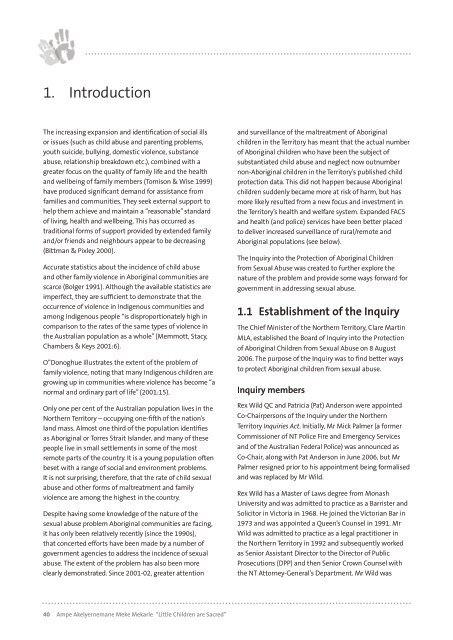bipacsa_final_report
bipacsa_final_report
bipacsa_final_report
You also want an ePaper? Increase the reach of your titles
YUMPU automatically turns print PDFs into web optimized ePapers that Google loves.
1. Introduction<br />
The increasing expansion and identification of social ills<br />
or issues (such as child abuse and parenting problems,<br />
youth suicide, bullying, domestic violence, substance<br />
abuse, relationship breakdown etc.), combined with a<br />
greater focus on the quality of family life and the health<br />
and wellbeing of family members (Tomison & Wise 1999)<br />
have produced significant demand for assistance from<br />
families and communities. They seek external support to<br />
help them achieve and maintain a “reasonable” standard<br />
of living, health and wellbeing. This has occurred as<br />
traditional forms of support provided by extended family<br />
and/or friends and neighbours appear to be decreasing<br />
(Bittman & Pixley 2000).<br />
Accurate statistics about the incidence of child abuse<br />
and other family violence in Aboriginal communities are<br />
scarce (Bolger 1991). Although the available statistics are<br />
imperfect, they are sufficient to demonstrate that the<br />
occurrence of violence in Indigenous communities and<br />
among Indigenous people “is disproportionately high in<br />
comparison to the rates of the same types of violence in<br />
the Australian population as a whole” (Memmott, Stacy,<br />
Chambers & Keys 2001:6).<br />
O”Donoghue illustrates the extent of the problem of<br />
family violence, noting that many Indigenous children are<br />
growing up in communities where violence has become “a<br />
normal and ordinary part of life” (2001:15).<br />
Only one per cent of the Australian population lives in the<br />
Northern Territory – occupying one-fifth of the nation’s<br />
land mass. Almost one third of the population identifies<br />
as Aboriginal or Torres Strait Islander, and many of these<br />
people live in small settlements in some of the most<br />
remote parts of the country. It is a young population often<br />
beset with a range of social and environment problems.<br />
It is not surprising, therefore, that the rate of child sexual<br />
abuse and other forms of maltreatment and family<br />
violence are among the highest in the country.<br />
Despite having some knowledge of the nature of the<br />
sexual abuse problem Aboriginal communities are facing,<br />
it has only been relatively recently (since the 1990s),<br />
that concerted efforts have been made by a number of<br />
government agencies to address the incidence of sexual<br />
abuse. The extent of the problem has also been more<br />
clearly demonstrated. Since 2001-02, greater attention<br />
0 Ampe Akelyernemane Meke Mekarle “Little Children are Sacred”<br />
and surveillance of the maltreatment of Aboriginal<br />
children in the Territory has meant that the actual number<br />
of Aboriginal children who have been the subject of<br />
substantiated child abuse and neglect now outnumber<br />
non-Aboriginal children in the Territory’s published child<br />
protection data. This did not happen because Aboriginal<br />
children suddenly became more at risk of harm, but has<br />
more likely resulted from a new focus and investment in<br />
the Territory’s health and welfare system. Expanded FACS<br />
and health (and police) services have been better placed<br />
to deliver increased surveillance of rural/remote and<br />
Aboriginal populations (see below).<br />
The Inquiry into the Protection of Aboriginal Children<br />
from Sexual Abuse was created to further explore the<br />
nature of the problem and provide some ways forward for<br />
government in addressing sexual abuse.<br />
1.1 Establishment of the Inquiry<br />
The Chief Minister of the Northern Territory, Clare Martin<br />
MLA, established the Board of Inquiry into the Protection<br />
of Aboriginal Children from Sexual Abuse on 8 August<br />
2006. The purpose of the Inquiry was to find better ways<br />
to protect Aboriginal children from sexual abuse.<br />
Inquiry members<br />
Rex Wild QC and Patricia (Pat) Anderson were appointed<br />
Co-Chairpersons of the Inquiry under the Northern<br />
Territory Inquiries Act. Initially, Mr Mick Palmer (a former<br />
Commissioner of NT Police Fire and Emergency Services<br />
and of the Australian Federal Police) was announced as<br />
Co-Chair, along with Pat Anderson in June 2006, but Mr<br />
Palmer resigned prior to his appointment being formalised<br />
and was replaced by Mr Wild.<br />
Rex Wild has a Master of Laws degree from Monash<br />
University and was admitted to practice as a Barrister and<br />
Solicitor in Victoria in 1968. He joined the Victorian Bar in<br />
1973 and was appointed a Queen’s Counsel in 1991. Mr<br />
Wild was admitted to practice as a legal practitioner in<br />
the Northern Territory in 1992 and subsequently worked<br />
as Senior Assistant Director to the Director of Public<br />
Prosecutions (DPP) and then Senior Crown Counsel with<br />
the NT Attorney-General’s Department. Mr Wild was


